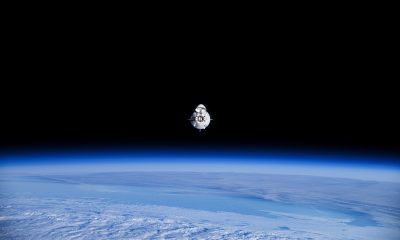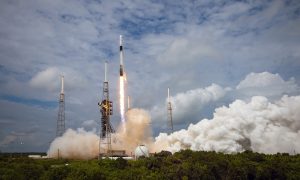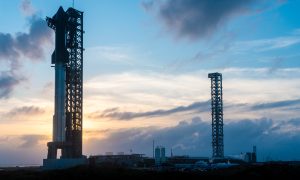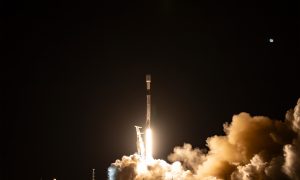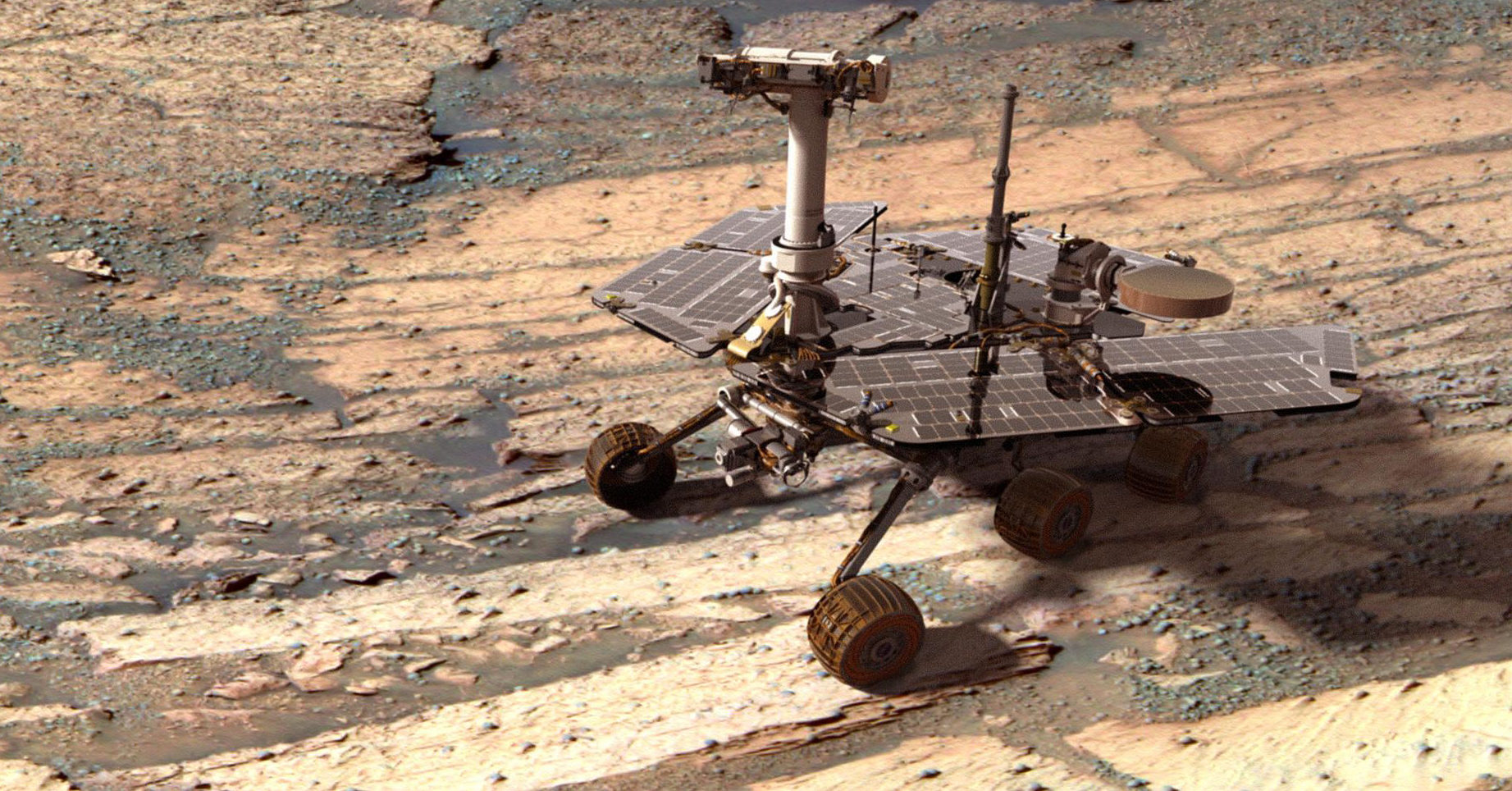

News
Fate of NASA’s Opportunity rover unknown as Martian dust storm reaches peak strength
As NASA’s Opportunity Rover continues to weather the massive dust storm engulfing a quarter part of the Red Planet, the silence from the resilient rover has now stretched to three weeks. Despite this, however, Dr. James Rice, co-investigator and geology team leader on NASA projects including Opportunity, recently stated that it is far too early to speculate the rover’s demise, considering the grit and durability the machine has exhibited over the past 14 years.
In an article on Spaceflight Insider, Dr. Rice noted that NASA received the last power reading from Opportunity on Sol 5111 (June 10, 2018), when the rover collected a measly 22 Wh worth of solar power. Just ten days prior to the reading, Opportunity was still able to collect 645 Wh of energy from the Sun. Despite the lack of sunlight due to the dust storm, however, Dr. Rice noted that the timing of the storm could work in Opportunity’s favor, since the warm Martian Spring could help keep the rover’s electronics from becoming too cold during the night.
“We went from generating a healthy 645 watt-hours on June 1 to an unheard of, life-threatening, low just about one week later. Our last power reading on June 10 was only 22 watt hours the lowest we have ever seen. Our thermal experts think that we will stay above those low critical temperatures because we have a Warm Electronics Box (WEB) that is well insulated. So we are not expecting any thermal damage to the batteries or computer systems. Fortunately for us it is also the Martian Spring and the dust, while hindering our solar power in the day, helps keep us warmer at night,” Dr. Rice wrote.
Opportunity is currently weathering the Martian dust storm on the slopes of Perseverance Valley, where it is analyzing the planet’s geology. As the storm broke out, NASA opted to keep the rover’s robotic arm deployed on its rock target, La Joya. The dust storm, which covered 15.8 million square miles (41 million square kilometers) as of mid-June, started at a rather unusual time. Dust storms in the Red Planet, after all, usually form during the Martian Summer. Only one other dust event during the Martian Spring was recorded by NASA back in 2001, but it started significantly later than the current storm.
Despite the very real danger Opportunity is facing, NASA remains optimistic about the resilient rover’s chances. Just recently, NASA’s Mars Exploration Program director Jim Watzin stated that the massive Martian dust storm silencing Opportunity might have already peaked. Considering that the storm took roughly a month to build up, however, Watzin noted that it could also be a “substantial” amount of time before the dust event settles enough for NASA to properly determine Opportunity’s fate, as noted in a Twitter update from Space News senior writer Jeff Foust.
Watzin: the Martian dust storm that silenced Opportunity may be peaking now, but it took a month to build up and thus could be a “substantial” amount of time before it subsides.
— Jeff Foust (@jeff_foust) July 2, 2018
Opportunity is currently the longest-serving rover on the Martian landscape. Launched back in 2004, Opportunity, together with its sister, Spirit, were designed to last for a 90-day mission. Both rovers proved far more durable than expected, however, with Spirit continuing its mission for six years before falling silent in 2010 and Opportunity still going strong well into 2018. Overall, the work done by Opportunity, Spirit, as well as the nuclear-powered Curiosity, have laid the groundwork for more ambitious missions to the Red Planet. Among these are Mars 2020, a machine based on Curiosity, as well as Europe’s ExoMars rover, both of which would be sent to Mars in order to find signs of life.
News
Tesla begins Robotaxi certification push in Arizona: report
Tesla seems serious about expanding its Robotaxi service to several states in the coming months.

Tesla has initiated discussions with Arizona transportation regulators to certify its driverless Robotaxi service in the state, as per a recent report from Bloomberg News. The move follows Tesla’s launch of its Robotaxi pilot program in Austin, Texas, as well as CEO Elon Musk’s recent comments about the service’s expansion in the Bay Area.
The Arizona Department of Transportation confirmed to Bloomberg that Tesla has reached out to begin the certification process for autonomous ride-sharing operations in the state. While details remain limited, the outreach suggests that Tesla is serious about expanding its driverless Robotaxi service to several territories in the coming months.
The Arizona development comes as Tesla prepares to expand its service area in Austin this weekend, as per CEO Elon Musk in a post on X. Musk also stated that Tesla is targeting the San Francisco Bay Area as its next major market, with a potential launch “in a month or two,” pending regulatory approvals.
Tesla first launched its autonomous ride-hailing program on June 22 in Austin with a small fleet of Model Y vehicles, accompanied by a Tesla employee in the passenger seat to monitor safety. While still classified as a test, Musk has said the program will expand to about 1,000 vehicles in the coming months. Tesla will later upgrade its Robotaxi fleet with the Cyercab, a two-seater that is designed without a steering wheel.
Sightings of Cybercab castings around the Giga Texas complex suggests that Tesla may be ramping the initial trial production of the self-driving two-seater. Tesla, for its part, has noted in the past that volume production of the Cybercab is expected to start sometime next year.
In California, Tesla has already applied for a transportation charter-party carrier permit from the state’s Public Utilities Commission. The company is reportedly taking a phased approach to operating in California, with the Robotaxi service starting with pre-arranged rides for employees in vehicles with safety drivers.
News
Tesla sets November 6 date for 2025 Annual Shareholder Meeting
The automaker announced the date on Thursday in a Form 8-K.

Tesla has scheduled its 2025 annual shareholder meeting for November 6, addressing investor concerns that the company was nearing a legal deadline to hold the event.
The automaker announced the date on Thursday in a Form 8-K submitted to the United States Securities and Exchange Commission (SEC). The company also listed a new proposal submission deadline of July 31 for items to be included in the proxy statement.
Tesla’s announcement followed calls from a group of 27 shareholders, including the leaders of large public pension funds, which urged Tesla’s board to formally set the meeting date, as noted in a report from The Wall Street Journal.
The group noted that under Texas law, where Tesla is now incorporated, companies must hold annual meetings within 13 months of the last one if requested by shareholders. Tesla’s previous annual shareholder meeting was held on June 13, 2024, which placed the July 13 deadline in focus.
Tesla originally stated in its 2024 annual report that it would file its proxy statement by the end of April. However, an amended filing on April 30 indicated that the Board of Directors had not yet finalized a meeting date, at least at the time.
The April filing also confirmed that Tesla’s board had formed a special committee to evaluate certain matters related to CEO Elon Musk’s compensation plan. Musk’s CEO performance award remains at the center of a lengthy legal dispute in Delaware, Tesla’s former state of incorporation.
Due to the aftermath of Musk’s legal dispute about his compensation plan in Delaware, he has not been paid for his work at Tesla for several years. Musk, for his part, has noted that he is more concerned about his voting stake in Tesla than his actual salary.
At last year’s annual meeting, TSLA shareholders voted to reapprove Elon Musk’s compensation plan and ratified Tesla’s decision to relocate its legal domicile from Delaware to Texas.
Elon Musk
Grok coming to Tesla vehicles next week “at the latest:” Elon Musk
Grok’s rollout to Tesla vehicles is expected to begin next week at the latest.

Elon Musk announced on Thursday that Grok, the large language model developed by his startup xAI, will soon be available in Tesla vehicles. Grok’s rollout to Tesla vehicles is expected to begin next week at the latest, further deepening the ties between the two Elon Musk-led companies.
Tesla–xAI synergy
Musk confirmed the news on X shortly after livestreaming the release of Grok 4, xAI’s latest large language model. “Grok is coming to Tesla vehicles very soon. Next week at the latest,” Musk wrote in a post on social media platform X.
During the livestream, Musk and several members of the xAI team highlighted several upgrades to Grok 4’s voice capabilities and performance metrics, positioning the LLM as competitive with top-tier models from OpenAI and Google.
The in-vehicle integration of Grok marks a new chapter in Tesla’s AI development. While Tesla has long relied on in-house systems for autonomous driving and energy optimization, Grok’s integration would introduce conversational AI directly into its vehicles’ user experience. This integration could potentially improve customer interaction inside Tesla vehicles.
xAI and Tesla’s collaborative footprint
Grok’s upcoming rollout to Tesla vehicles adds to a growing business relationship between Tesla and xAI. Earlier this year, Tesla disclosed that it generated $198.3 million in revenue from commercial, consulting, and support agreements with xAI, as noted in a report from Bloomberg News. A large portion of that amount, however, came from the sale of Megapack energy storage systems to the artificial intelligence startup.
In July 2023, Musk polled X users about whether Tesla should invest $5 billion in xAI. While no formal investment has been made so far, 68% of poll participants voted yes, and Musk has since stated that the idea would be discussed with Tesla’s board.
-

 Elon Musk1 week ago
Elon Musk1 week agoTesla investors will be shocked by Jim Cramer’s latest assessment
-

 Elon Musk3 days ago
Elon Musk3 days agoElon Musk confirms Grok 4 launch on July 9 with livestream event
-

 Elon Musk15 hours ago
Elon Musk15 hours agoxAI launches Grok 4 with new $300/month SuperGrok Heavy subscription
-

 News7 days ago
News7 days agoTesla Model 3 ranks as the safest new car in Europe for 2025, per Euro NCAP tests
-

 Elon Musk2 weeks ago
Elon Musk2 weeks agoA Tesla just delivered itself to a customer autonomously, Elon Musk confirms
-

 Elon Musk1 week ago
Elon Musk1 week agoxAI’s Memphis data center receives air permit despite community criticism
-

 Elon Musk2 weeks ago
Elon Musk2 weeks agoTesla’s Omead Afshar, known as Elon Musk’s right-hand man, leaves company: reports
-

 News2 weeks ago
News2 weeks agoXiaomi CEO congratulates Tesla on first FSD delivery: “We have to continue learning!”




